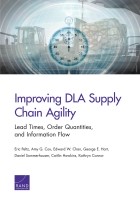| 来源类型 | Research Reports
|
| 规范类型 | 报告
|
| ISBN | 9780833088666
|
| 来源ID | RR-822-OSD
|
| Improving DLA Supply Chain Agility: Lead Times, Order Quantities, and Information Flow |
| Eric Peltz; Amy G. Cox; Ed Chan; George E. Hart; Daniel Sommerhauser; Caitlin Hawkins; Kathryn Connor
|
| 发表日期 | 2015
|
| 出版年 | 2015
|
| 页码 | 200
|
| 语种 | 英语
|
| 结论 |
- To fulfill its mission, DLA must maintain inventories of items for which demand can increase or decrease dramatically on short notice.
- DLA has maintained sufficient inventory to generally meet aggregate-level customer service goals.
- Meeting these goals has come in tandem with about $1 billion per year (2005–2013) in disposals — reflecting obsolescence, which is the biggest component of DLA's inventory holding costs — and extended stockouts for items with sudden demand increases.
- The buildup of excess inventory stems from inherent large errors when forecasting over long lead-time horizons and is exacerbated by sometimes suboptimal, large order quantities and delayed notification from customers of planned changes that will affect demand.
- Given its environment, the best remaining path to improved supply chain efficiency and effectiveness is for DLA to improve supply chain agility, which is the ability to effectively respond to changes in demand and supply.
- The initial emphasis should be on being alert to and improving response to changes in demand by reducing lead-times, right-sizing order quantities, and improving customer information flow and utilization of the information by DLA.
|
| 摘要 |
- Increase enterprisewide emphasis on supply chain agility, with involvement from the most-senior management levels across the DoD supply chain management enterprise and flowing downward to all levels. Continuous attention to supply chain agility should become part of the supply chain DNA.
- Continue to broaden efforts to shorten administrative and production lead times by working collaboratively with suppliers, incorporating production lead time into bid and supplier selection, and developing a best value tool to account for price, lead time, and order quantity trade-offs.
- Optimize order quantities by basing them on economic order quantities with an inventory holding cost that closely approximates the estimated DLA holding cost, avoiding manual adjustments.
- Continue expanding the use of long-term contracts, especially with guaranteed minimums and longer lengths, and where low-demand and high-demand items can be combined.
- Pursue efforts with the armed services to improve the flow of information about upcoming item changes from customers to DLA.
|
| 主题 | Military Acquisition and Procurement
; Military Budgets and Defense Spending
; Military Logistics
|
| URL | https://www.rand.org/pubs/research_reports/RR822.html
|
| 来源智库 | RAND Corporation (United States)
|
| 资源类型 | 智库出版物
|
| 条目标识符 | http://119.78.100.153/handle/2XGU8XDN/108084
|
推荐引用方式
GB/T 7714 |
Eric Peltz,Amy G. Cox,Ed Chan,et al. Improving DLA Supply Chain Agility: Lead Times, Order Quantities, and Information Flow. 2015.
|
|
文件名:
|
x1495316334527.jpg
|
|
格式:
|
JPEG
|

|
文件名:
|
RAND_RR822.pdf
|
|
格式:
|
Adobe PDF
|
此文件暂不支持浏览
除非特别说明,本系统中所有内容都受版权保护,并保留所有权利。